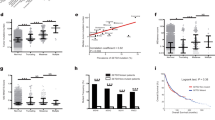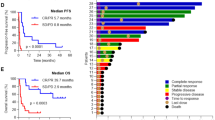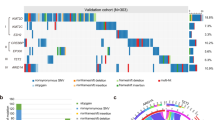Abstract
Background
Epigenetic alteration plays an essential role in the occurrence and development of extranodal natural killer/T cell lymphoma (ENKTL). Histone methyltransferase (HMT) KMT2D is an epigenetic regulator that plays different roles in different tumors, but its role and mechanism in ENKTL are still unclear.
Methods
We performed immunohistochemical staining of 112 ENKTL formalin-fixed paraffin-embedded (FFPE) samples. Then, we constructed KMT2D knockdown cell lines and conducted research on cell biological behavior. Finally, to further investigate KMT2D-mediated downstream genes, ChIP-seq and ChIP -qPCR was performed.
Results
The low expression of KMT2D was related to a decreased abundance in histone H3 lysine 4 mono- and trimethylation (H3K4me1/3). In KMT2D knockdown YT and NK-YS cells, cell proliferation was faster (P < 0.05), apoptosis was decreased (P < 0.05), the abundance of S phase cells was increased (P < 0.05), and the level of H3K4me1 was decreased. Notably, ChIP-seq revealed two crucial genes and pathways downregulated by KMT2D.
Conclusions
KMT2D is a tumor suppressor gene that mediates H3K4me1 and influences ENKTL proliferation and apoptosis by regulating the cell cycle. Moreover, in ENKTL, serum- and glucocorticoid-inducible kinase-1 (SGK1) and suppressor of cytokine signaling-1 (SOCS1) are downstream genes of KMT2D.



Similar content being viewed by others
Data availability
The data that support the findings of this study are available on request from the corresponding author. The data are not publicly available due to their containing information that could compromise the privacy of research participants.
Abbreviations
- ENKTL:
-
extranodal natural killer/T cell lymphoma
- HMT:
-
histone methyltransferase
- FFPE:
-
formalin-fixed paraffin-embedded
- H3K4me1/2/3:
-
monomethylation, dimethylation or trimethylation of histone 3 lysine 4
- SGK1 :
-
serum- and glucocorticoid-inducible kinase-1
- SOCS1 :
-
suppressor of cytokine signaling-1
- EBV:
-
Epstein–Barr virus
- WHO:
-
World Health Organization
- FBS:
-
foetal bovine serum
- MOI:
-
multiplicity of infection
- NC:
-
negative control
- DAB:
-
diaminobenzidine
- BCA:
-
bicinchoninic acid
- PVDF:
-
polyvinylidene difluoride
- ECL:
-
electrochemiluminescence
- CCK8:
-
Cell Counting Kit-8
- KEGG:
-
Kyoto Encyclopedia of Genes and Genomes
- χ2 :
-
chi-square
- OS:
-
overall survival
- SEM:
-
standard error of the mean
- PTCL-NOS:
-
peripheral T cell lymphoma, not otherwise specified
- GC:
-
germinal center
References
Alam H, Tang M, Maitituoheti M, Dhar SS, Kumar M, Han CY, Ambati CR, Amin SB, Gu B, Chen TY et al (2020) KMT2D Deficiency impairs super-enhancers to Confer a glycolytic vulnerability in Lung Cancer. Cancer Cell 37:599–617e597
Arber DA, Orazi A, Hasserjian R, Thiele J, Borowitz MJ, Le Beau MM, Bloomfield CD, Cazzola M, Vardiman JW (2016) The 2016 revision to the World Health Organization classification of myeloid neoplasms and acute leukemia. Blood 127:2391–2405
Ehrentraut S, Schneider B, Nagel S, Pommerenke C, Quentmeier H, Geffers R, Feist M, Kaufmann M, Meyer C, Kadin ME et al (2016) Th17 cytokine differentiation and loss of plasticity after SOCS1 inactivation in a cutaneous T-cell lymphoma. Oncotarget 7:34201–34216
Gao LM, Zhao S, Zhang WY, Wang M, Li HF, Lizaso A, Liu WP (2019) Somatic mutations in KMT2D and TET2 associated with worse prognosis in Epstein-Barr virus-associated T or natural killer-cell lymphoproliferative disorders. Cancer Biol Ther 20:1319–1327
Grasso CS, Wu YM, Robinson DR, Cao X, Dhanasekaran SM, Khan AP, Quist MJ, Jing X, Lonigro RJ, Brenner JC et al (2012) The mutational landscape of lethal castration-resistant prostate cancer. Nature 487:239–243
Guo C, Chen LH, Huang Y, Chang CC, Wang P, Pirozzi CJ, Qin X, Bao X, Greer PK, McLendon RE et al (2013) KMT2D maintains neoplastic cell proliferation and global histone H3 lysine 4 monomethylation. Oncotarget 4:2144–2153
Ji MM, Huang YH, Huang JY, Wang ZF, Fu D, Liu H, Liu F, Leboeuf C, Wang L, Ye J et al (2018) Histone modifier gene mutations in peripheral T-cell lymphoma not otherwise specified. Haematologica 103:679–687
Jiang L, Gu ZH, Yan ZX, Zhao X, Xie YY, Zhang ZG, Pan CM, Hu Y, Cai CP, Dong Y et al (2015) Exome sequencing identifies somatic mutations of DDX3X in natural killer/T-cell lymphoma. Nat Genet 47:1061–1066
Kämmerer U, Kapp M, Gassel AM, Richter T, Tank C, Dietl J, Ruck P (2001) A new rapid immunohistochemical staining technique using the EnVision antibody complex. J Histochem Cytochem 49:623–630
Kim JH, Sharma A, Dhar SS, Lee SH, Gu B, Chan CH, Lin HK, Lee MG (2014) UTX and MLL4 coordinately regulate transcriptional programs for cell proliferation and invasiveness in breast cancer cells. Cancer Res 74:1705–1717
Küçük C, Jiang B, Hu X, Zhang W, Chan JK, Xiao W, Lack N, Alkan C, Williams JC, Avery KN et al (2015) Activating mutations of STAT5B and STAT3 in lymphomas derived from γδ-T or NK cells. Nat Commun 6:6025
Kwong YL (2005) Natural killer-cell malignancies: diagnosis and treatment. Leukemia 19:2186–2194
Kwong YL, Kim WS, Lim ST, Kim SJ, Tang T, Tse E, Leung AY, Chim CS (2012) SMILE for natural killer/T-cell lymphoma: analysis of safety and efficacy from the Asia Lymphoma Study Group. Blood 120:2973–2980
Kwong YL, Chan TSY, Tan D, Kim SJ, Poon LM, Mow B, Khong PL, Loong F, Au-Yeung R, Iqbal J et al (2017) PD1 blockade with pembrolizumab is highly effective in relapsed or refractory NK/T-cell lymphoma failing l-asparaginase. Blood 129:2437–2442
Lee JE, Wang C, Xu S, Cho YW, Wang L, Feng X, Baldridge A, Sartorelli V, Zhuang L, Peng W et al (2013) H3K4 mono- and di-methyltransferase MLL4 is required for enhancer activation during cell differentiation. Elife 2:e01503
Lee S, Park HY, Kang SY, Kim SJ, Hwang J, Lee S, Kwak SH, Park KS, Yoo HY, Kim WS et al (2015) Genetic alterations of JAK/STAT cascade and histone modification in extranodal NK/T-cell lymphoma nasal type. Oncotarget 6:17764–17776
Li H, Durbin R (2009) Fast and accurate short read alignment with Burrows-Wheeler transform. Bioinformatics 25:1754–1760
Morin RD, Mendez-Lago M, Mungall AJ, Goya R, Mungall KL, Corbett RD, Johnson NA, Severson TM, Chiu R, Field M et al (2011) Frequent mutation of histone-modifying genes in non-hodgkin lymphoma. Nature 476:298–303
Ortega-Molina A, Boss IW, Canela A, Pan H, Jiang Y, Zhao C, Jiang M, Hu D, Agirre X, Niesvizky I et al (2015) The histone lysine methyltransferase KMT2D sustains a gene expression program that represses B cell lymphoma development. Nat Med 21:1199–1208
Pasqualucci L, Khiabanian H, Fangazio M, Vasishtha M, Messina M, Holmes AB, Ouillette P, Trifonov V, Rossi D, Tabbò F et al (2014) Genetics of follicular lymphoma transformation. Cell Rep 6:130–140
Ruthenburg AJ, Allis CD, Wysocka J (2007) Methylation of lysine 4 on histone H3: intricacy of writing and reading a single epigenetic mark. Mol Cell 25:15–30
Salem ME, Battaglin F, Goldberg RM, Puccini A, Shields AF, Arguello D, Korn WM, Marshall JL, Grothey A, Lenz HJ (2020) Molecular analyses of Left- and right-sided tumors in adolescents and young adults with colorectal Cancer. Oncologist 25:404–413
Schif B, Lennerz JK, Kohler CW, Bentink S, Kreuz M, Melzner I, Ritz O, Trümper L, Loeffler M, Spang R et al (2013) SOCS1 mutation subtypes predict divergent outcomes in diffuse large B-Cell lymphoma (DLBCL) patients. Oncotarget 4:35–47
Schmittgen TD, Livak KJ (2008) Analyzing real-time PCR data by the comparative C(T) method. Nat Protoc 3:1101–1108
Song TL, Nairismägi ML, Laurensia Y, Lim JQ, Tan J, Li ZM, Pang WL, Kizhakeyil A, Wijaya GC, Huang DC et al (2018) Oncogenic activation of the STAT3 pathway drives PD-L1 expression in natural killer/T-cell lymphoma. Blood 132:1146–1158
Tse E, Kwong YL (2013) How I treat NK/T-cell lymphomas. Blood 121:4997–5005
Tse E, Kwong YL (2017) The diagnosis and management of NK/T-cell lymphomas. J Hematol Oncol 10:85
Tsuchiyama J, Yoshino T, Mori M, Kondoh E, Oka T, Akagi T, Hiraki A, Nakayama H, Shibuya A, Ma Y et al (1998) Characterization of a novel human natural killer-cell line (NK-YS) established from natural killer cell lymphoma/leukemia associated with Epstein-Barr virus infection. Blood 92:1374–1383
Weniger MA, Melzner I, Menz CK, Wegener S, Bucur AJ, Dorsch K, Mattfeldt T, Barth TF, Möller P (2006) Mutations of the tumor suppressor gene SOCS-1 in classical Hodgkin lymphoma are frequent and associated with nuclear phospho-STAT5 accumulation. Oncogene 25:2679–2684
Wong GC, Li KK, Wang WW, Liu AP, Huang QJ, Chan AK, Poon MF, Chung NY, Wong QH, Chen H et al (2020) Clinical and mutational profiles of adult medulloblastoma groups. Acta Neuropathol Commun 8:191
Xiong J, Cui BW, Wang N, Dai YT, Zhang H, Wang CF, Zhong HJ, Cheng S, Ou-Yang BS, Hu Y et al (2020) Genomic and transcriptomic characterization of natural killer T cell lymphoma. Cancer Cell 37:403–419e406
Yagita M, Huang CL, Umehara H, Matsuo Y, Tabata R, Miyake M, Konaka Y, Takatsuki K (2000) A novel natural killer cell line (KHYG-1) from a patient with aggressive natural killer cell leukemia carrying a p53 point mutation. Leukemia 14:922–930
Yamaguchi M, Kwong YL, Kim WS, Maeda Y, Hashimoto C, Suh C, Izutsu K, Ishida F, Isobe Y, Sueoka E et al (2011) Phase II study of SMILE chemotherapy for newly diagnosed stage IV, relapsed, or refractory extranodal natural killer (NK)/T-cell lymphoma, nasal type: the NK-Cell Tumor Study Group study. J Clin Oncol 29:4410–4416
Yodoi J, Teshigawara K, Nikaido T, Fukui K, Noma T, Honjo T, Takigawa M, Sasaki M, Minato N, Tsudo M et al (1985) TCGF (IL 2)-receptor inducing factor(s). I. Regulation of IL 2 receptor on a natural killer-like cell line (YT cells). J Immunol 134:1623–1630
Yu G, Wang LG, He QY (2015) ChIPseeker: an R/Bioconductor package for ChIP peak annotation, comparison and visualization. Bioinformatics 31:2382–2383
Yu P, Wang Y, Yu Y, Wang A, Huang L, Zhang Y, Liu W, Wu H, Yao M, Du YA et al (2021) Deep Targeted Sequencing and Its Potential Implication for Cancer Therapy in Chinese Patients with Gastric Adenocarcinoma. Oncologist
Zhang Y, Liu T, Meyer CA, Eeckhoute J, Johnson DS, Bernstein BE, Nusbaum C, Myers RM, Brown M, Li W et al (2008) Model-based analysis of ChIP-Seq (MACS). Genome Biol 9:R137
Zhang J, Grubor V, Love CL, Banerjee A, Richards KL, Mieczkowski PA, Dunphy C, Choi W, Au WY, Srivastava G et al (2013) Genetic heterogeneity of diffuse large B-cell lymphoma. Proc Natl Acad Sci U S A 110:1398–1403
Zhang J, Dominguez-Sola D, Hussein S, Lee JE, Holmes AB, Bansal M, Vlasevska S, Mo T, Tang H, Basso K et al (2015) Disruption of KMT2D perturbs germinal center B cell development and promotes lymphomagenesis. Nat Med 21:1190–1198
Acknowledgements
Not applicable.
Funding
This study was financially supported by the national natural science foundation of China (81900197, 81272626) and the Science and Technology Program of Sichuan Province (2020YJ0104).
Author information
Authors and Affiliations
Contributions
YHZ and QT designed the study, analyzed and interpreted the data; YHZ and LMG were major contributors to writing the manuscript. WYZ and SZ revised the manuscript. WPL and LMG were responsible for the acquisition of data and institutional review board application, and gave final approval for the version to be published. All authors read and approved the final manuscript.
Corresponding authors
Ethics declarations
Conflict of Interest
The authors declare that the research was conducted in the absence of any commercial or financial relationships that could be construed as a potential conflict of interest.
Ethics approval
The Medical Ethics Committee of West China Hospital of Sichuan University approved this study (registration number: WCH2019-00121). All recruited patients gave written informed consent following the Declaration of Helsinki.
Consent to participate
Informed consent was obtained from all individual participants included in the study.
Consent for publish
All authors agreed to publish this manuscript.
Additional information
Publisher’s Note
Springer Nature remains neutral with regard to jurisdictional claims in published maps and institutional affiliations.
Electronic supplementary material
Below is the link to the electronic supplementary material.
Rights and permissions
Springer Nature or its licensor (e.g. a society or other partner) holds exclusive rights to this article under a publishing agreement with the author(s) or other rightsholder(s); author self-archiving of the accepted manuscript version of this article is solely governed by the terms of such publishing agreement and applicable law.
About this article
Cite this article
Zhang, YH., Tao, Q., Zhang, WY. et al. Histone methyltransferase KMT2D inhibits ENKTL carcinogenesis by epigenetically activating SGK1 and SOCS1. Genes Genom 46, 203–212 (2024). https://doi.org/10.1007/s13258-023-01434-1
Received:
Accepted:
Published:
Issue Date:
DOI: https://doi.org/10.1007/s13258-023-01434-1




